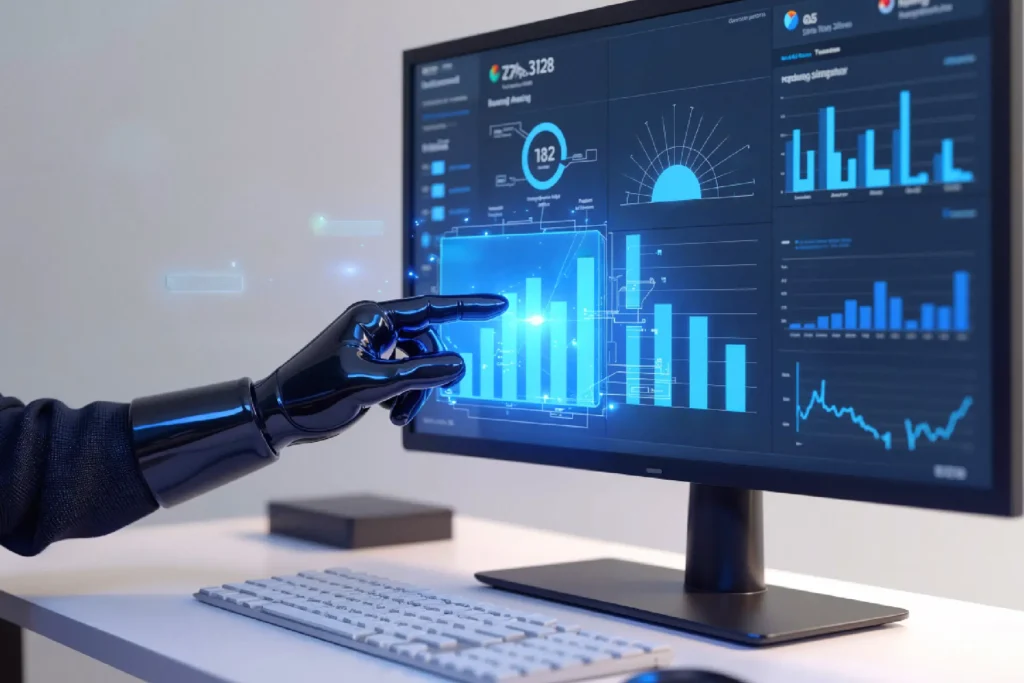Smarter Finance – AI in ERP Accounting & Forecasting

Introduction: From Data Entry to Data Intelligence
Finance is the lifeline of any organization—and one of the most structured, data-rich components of any ERP system. Yet, most finance teams still spend countless hours on manual entries, reconciliations, and report generation. AI is changing that.
By automating routine tasks, enhancing data accuracy, and enabling predictive insights, AI brings a new layer of intelligence to ERP finance modules—unlocking strategic value beyond basic accounting. In today’s post, we explore how AI can transform ERP-powered finance operations from reactive bookkeeping to real-time, forward-looking decision support.
The Challenges with Traditional ERP Finance
While ERP systems have streamlined financial processes, they still rely heavily on:
- Manual invoice validation and approval
- Rule-based reconciliation
- Static budgeting and forecasting
- Delayed period closing processes
These processes are time-consuming, error-prone, and often blind to emerging risks.
What AI Brings to ERP Finance Modules
By integrating AI into the finance layer of your ERP, you can:
Automate Reconciliation & Anomaly Detection
- Match transactions with GL entries in real-time
- Flag duplicate, missing, or fraudulent entries
- Identify irregular cash flow or spend anomalies
Predict Cash Flow and Working Capital
- Use time series models to forecast cash inflows/outflows
- Factor in seasonal patterns, vendor behavior, and AR/AP cycles
Intelligent Invoice & Expense Processing
- Auto-extract fields from scanned invoices using computer vision
- Route invoices dynamically based on value, category, or risk score
- Classify expenses and match with PO/GRN entries automatically
Smart Budgeting and Forecasting
- Apply machine learning to historical budget vs actual trends
- Suggest dynamic budget adjustments mid-cycle
- Provide scenario analysis based on live operational inputs
Real-time Financial Alerts
- Trigger alerts for budget overruns, payment delays, or unusual account behavior
- Push personalized finance reports to CFO dashboards or mobile apps
Example: AI-Driven Accounts Payable Workflow
- OCR + NLP extract data from supplier invoice (vendor name, amount, due date)
- Duplicate Detection checks for similar invoices in the system
- ML Classifier assigns GL code and payment priority
- Approval Bot routes it based on AI-defined risk level
- ERP Integration auto-posts the entry and updates AP ledger
Result: Faster turnaround, fewer errors, and complete audit trail.
Tools & Tech Stack
- OCR: Tesseract, EasyOCR, LayoutLMv3
- Anomaly Detection: Isolation Forest, Autoencoders, Prophet
- Forecasting Models: ARIMA, LSTM, XGBoost
- APIs: Integration with Oracle, SAP, Odoo, or custom Laravel/PostgreSQL-based ERP
- Dashboards: Power BI, Metabase, or embedded BI in ERP modules
Business Outcomes
- 60% reduction in invoice processing time
- 5% improvement in cash flow prediction accuracy
- 80% drop in reconciliation errors
- 3x faster period-end closing
These aren’t pilot experiments—they’re production wins for finance teams that embed just the right amount of AI into their workflows.
Final Thoughts: Finance That Thinks Ahead
Your finance team shouldn’t just report the past—they should shape the future.
By adding intelligence to your ERP’s finance layer, you can move from data entry to data strategy, giving CFOs and controllers the insights they need—before they need them.
Coming tomorrow: How AI is empowering HR teams with predictive and personalized tools—from attendance to attrition.


